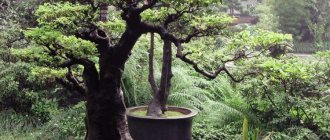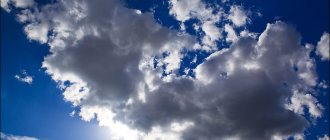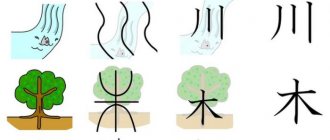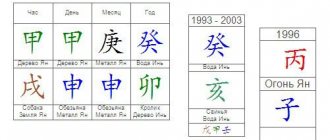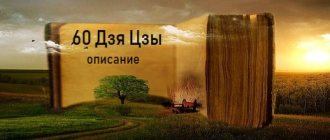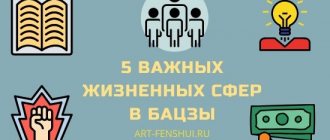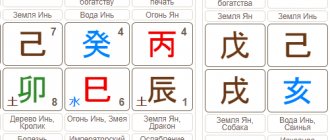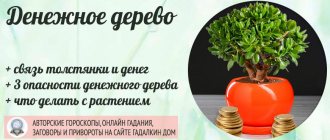The Five Elements, or elements, system is one of the main foundations. It is believed that the interaction of Yin-Yang allows Qi energy to exist in different forms. And they are called the five elements - Wood, Fire, Earth, Metal, Water.
Nature and the external environment can be described by a system of 5 elements. If you delve into the essence of this theory and learn to understand it, you can achieve amazing results.
In China, since ancient times, the principle of the Five Elements has been widely used - for fortune telling, in martial arts, Qi Gong, and medicine. After all, all objects and phenomena, including emotions, food, and even we ourselves consist of Five Elements!
The Chinese gave this principle the name Wu Xing, which means five transformations, or five phases of Qi energy and divided any life process into five stages of development:
- The beginning of the journey and growth. During this phase, the Qi energy rapidly grows upward, like a Tree . It is persistent and persistent.
- Then comes the peak of development - like Fire, has a maximum of energy rushing in different directions.
- The next phase is energy stabilization. She is like the Earth - reliable, powerful, stable.
- Then inevitably comes decline. Energy acquires the properties of Metal - it is compressed inward, concentrated, and hardened.
- The end of life and the beginning of a new cycle in development - Water . It flows freely, penetrates inside, and permeates everything around it.
Relationships of 5 elements
Everything must be born, and so our five elements are also born. In the birth cycle, one type of Qi energy helps another to arise, nourishing and strengthening it. Wood intensifies Fire - when wood is thrown into the flame, it burns brighter. From Fire, ashes are formed - the basis for the Earth. Metal appears in the depths of the Earth. He, in turn, helps Water to be born. And Water nourishes the Tree.
There are 5 elements in the birth cycle:
- Tree gives birth to Fire
- Fire gives birth to Earth
- Earth gives birth to Metal
- Metal gives birth to Water
- Water gives birth to a tree
In the cycle of control, also called the cycle of control, one of the elements controls and suppresses the other to create balance. Metal cuts Wood, controlling its shape, and Wood, in turn, controls the Earth, receiving useful substances from it. Earth stops the flow of Water, Water extinguishes Fire, and Fire melts Metal.
There are 5 elements in the control cycle:
- The tree controls the earth
- Earth controls Water
- Water controls Fire
- Fire controls Metal
- Metal controls Wood
Achieving balance
The five elements require harmony in your life. And since we spend a significant part of it at home, that’s where we need to start.
Water. Various clutter, plumbing malfunctions, doors that do not close - all this can cause an imbalance in the water element. There can be either over-stimulation or under-stimulation. In the first case, the cause may be excessively large aquariums or photographs/paintings with water landscapes. You should get rid of such elements or, on the contrary, add them to the interior if there is a shortage. You should also not drink too much coffee or eat salt.
Tree. Heavy furniture, bulky cabinets, everything that can symbolize inflexibility and inactivity, heaviness. It is worth replacing such items with lighter and more elegant ones. Bamboo is ideal in this case. Animal food in the diet should be limited. It is also important to do exercises and learn to relax. Allow yourself to fool around - it's a great way to relax.
Fire. A large concentration of household appliances and electrical appliances in one place can upset the balance of this element. It is best to separate equipment into different rooms. Add also calm and beautiful paintings or figurines. On a personal level, try to see things through to the end, learn to be calm. This way you will learn to get satisfaction from life. It is better to forget about stimulants like coffee and alcohol.
Earth. The cause of the violation may be accumulations of objects that carry the essence of this element. If they are not used, it is better to get rid of them. All five elements require balance, and the Earth is not the least important here. The space needs to be cleared, which will allow the Chi energy to circulate freely. A balance of free space and furniture should be maintained in all rooms. It is also important to play sports and various physical activities.
Metal. Shows imbalance in stingy, cold or orderly elements. Too many items associated with this symbol is very bad. Bring fun and joy into your home. Dilute all this with elements of Water to create mobility and flexibility in the interior. On a personal level, learn to be joyful, to have fun, to be festive. To do this, you can watch comedies, go to theaters, go to parties. Active physical mobility will also be beneficial.
Properties of the Five Elements
Each of the elements has its own properties, but the elements are not the materials themselves, but only their comparison with them. The properties that objects have indicate which of the five elements they belong to. Their names - Wood, Fire, Earth, Metal, Water will help you better understand the essence of the 5 types of Qi energy. But you should not take these words literally. Otherwise, you will go very far from a correct understanding of this system!
| Tree | Fire | Earth | Metal | Water | |
| Material | Wood, paper | Fire, heat | Ceramics, stone | Metal products | Water, glass |
| Color | Green | Red | Brown, yellow | Golden, white, gray | Black blue |
| Form | Vertical long rectangle | Triangle | Horizontal rectangle, square | Circle, sphere | Wavy irregular shape |
| Taste | Sour | Bitter | Sweet | Spicy | Salty |
| Side of the world | East Southeast | South | Northeast Southwest Center | West North-West | North |
For example, a round white ball is the element of Metal, and if it is black, then it already combines two elements - Metal and Water. A tall wooden cabinet painted red represents the elements of Wood and Fire. You can arrange any item yourself in this way and imagine it as a combination of 5 elements!
For Feng Shui purposes in the Five Elements, when creating an interior, color, shape and material are of primary importance, since they are the ones that are perceived first. But in food products, color and shape are no longer so important; taste plays the main role here.
You can see more qualities of the Five Elements here
Wu Xing 五行—5 Elements in Traditional Chinese Medicine.
According to the ideas of ancient scientists, there are inextricable connections between all five primary elements - interdependence and mutual oppression, which determine the state of their continuous movement and change (Xing - 行 (xíng) -movement) . The relationship of the main organs and their meridians with the five primary elements and some analogies; natural phenomena, human feelings, etc. (such analogies are varied); organs located outside the large circle belong to yang; the organs located inside the large circle belong to yin.
If the balance of the five primary elements is disturbed, then disease occurs.
For example, damage to any organ related to the earth element leads to a weakening of control over organs related to water. They intensify and inhibit the fire organs. - This is how disease arises.
Traditional Chinese medicine divides all human internal organs into main (solid) organs and accessory (hollow) organs.
Wu Zang 五脏(wǔzàng) – the main internal organs.
Liu Fo 六腑– additional internal organs.
The Zang organs have a dense structure, Yin character and are cumulative.
Fo organs have a hollow structure, Yang character and serve to receive, digest and excrete food.
And each of them corresponds to one of the five elements and one of the five primary colors.
Table of correspondences between the primary elements of Wu Xing, internal organs and color.
Wu Xing | Wu Zangdense organs yin character | Liu Fohollow organs character yang | color |
| tree | liver | gallbladder | green |
| fire | heart | small intestine | red |
| Earth | spleen | stomach | yellow |
| metal | lungs | colon | white |
| water | kidneys | bladder | black |
Don't be angry, don't worry. To be angry means the tree is bad, the liver is bad, the liver is weak, there is a lot of water, which weakens the liver even more. A weak liver cannot give birth to fire, weak fire interferes with earth, earth interferes with metal, metal interferes with water. This is a cycle of mutual influence of elements.
If there is enough wood, it gives fire, the heart feels warm. If the tree is weak, cannot give fire, does not give enough blood to the heart, the heart suffers.
This state has a common name - fear. It is similar to experience. It’s just that the experience is extended over time, and fear is a quick process. (Joy is a short time, and a pleasant state is a feeling for a long time).
The fire was supposed to give strength to the spleen. Its deficiency makes the spleen weak. The spleen provides energy to the lungs from water and food. A weak spleen causes weak lungs.
The lungs must lift water from the kidneys. Weak lung function leads to weak kidneys, and weak kidneys mean weak entire body.
Therefore, in case of illness, you need to look not only at the diseased organ, but at the entire body, since all organs are connected to each other. And you should always know exactly what is more in the body - Yang or Yin, in order to regulate and restore the Yin-Yang balance.
The mother-son rule.
Three primary elements (or their corresponding meridians) are considered; in relation to the primary element with disturbed energy, the previous primary element in the cycle of stimulating connections is called “mother”. and the next one is “son”.
The primary elements are, as it were, symbols of the main components of the material world and at the same time movement: wood - rebirth and growth, fire - the highest development, maximum activity, metal - the beginning of decline, water - minimal activity, passive force, earth - the center of cyclical changes. In the y-syn theory, the following types of relationships between the five primary elements are defined: normal mutually stimulating and mutually inhibiting connections, pathological - excessive and reverse inhibitory actions. By stimulating connections, stimulation, one should understand an action that promotes the emergence and development.
The sequence of mutual stimulation of the five primary elements is as follows : wood generates fire, fire generates earth, earth generates metal, metal generates water, water generates wood.
In these relationships, each primary element is simultaneously stimulated and stimulating. The stimulating element is figuratively represented as “mother”, and the stimulated element as “son”. For example: water is a stimulating element for wood, i.e. water is the “mother” of wood, and fire is the stimulated element in relation to wood, i.e. fire is the “son” of wood.
Based on the concept of y-xing, a “mother-son” acupuncture treatment rule has been built, which allows one to strengthen or weaken the “energy flow” in the meridian where this energy is disturbed. The primary element “mother” is capable of transmitting nourishing energy, and the primary element “son” is the recipient who receives this energy. If a pathology of one of the primary elements (meridians) occurs, but the impact directly on the disturbed meridian is undesirable, then the “mother-son” rule is used.
Xiang sheng 相生 (xiāngshēng) – mutual generation.
生我 – shēng wǒ – Sheng Wo – “Who gives birth to me.”
我生– wǒ shēng – Wo Sheng – “Whom I give birth to.”
According to this rule, three primary elements (meridians) are considered: 1) with disturbed energy; 2) preceding it and 3) following the violated one.
If excess energy is detected in a disturbed meridian (for example, in the gall bladder, wood), then you can act on the tonic point of the “son” meridian (small intestine, fire) or on the sedative point of the “mother” meridian (bladder, water); in case of insufficient energy in the disturbed meridian (wood), the effect is on the tonic point of the “mother” meridian (water) or on the sedative point of the “son” meridian (fire).
By oppression, mutually oppressive, destructive connections, we mean restraint and limitation.
The order of mutually oppressive connections between the five primary elements is as follows: wood oppresses earth, earth – water, water – fire, fire – metal, metal oppresses wood, i.e. in this relationship, each of the five primary elements is both oppressed and oppressor; for example, on the one hand, the tree is oppressed by metal, and on the other, the tree is oppressed by the earth.
In a complex natural relationship between objects and phenomena, there must necessarily be both stimulating and limiting connections. Without stimulation there would be no development, and development and growth without restrictions could be harmful, for example: wood stimulates fire and at the same time oppresses the earth, and the earth, in turn, stimulates metal and oppresses water. Thus, stimulation is limited by oppression, and oppression is compensated by stimulation, i.e. Thanks to these influences, the necessary (physiological) balance is maintained, ensuring the normal development of objects and phenomena (harmony).
In case of excess or deficiency of one of the five primary elements, abnormal, pathological types of interaction arise between them, defined as excessive and reverse inhibitory actions. Excessive inhibitory effect is manifested in excessive pathological oppression of that of the two interacting parties that is already weakened. The direction of excessive suppression in the cycle of the five primary elements is the same as with normal physiological suppression, but this is a pathological relationship that appears under certain conditions.
A reverse inhibitory effect means a weakening of the primary element, which has a direct inhibitory effect due to the excessive development of the suppressed element. The direction of the reverse inhibitory action is opposite to the direction of the direct inhibitory action in the y-syn cycle. Excessive and reverse inhibition resulting from pathology—excess or deficiency of one of the five primary elements—more often appear simultaneously, for example: if the primary element wood is excessive, then it excessively inhibits the primary element earth and has a reverse inhibitory effect on the primary element metal. If the primary element wood is insufficient, then, on the contrary, it experiences both reverse oppression from the primary element earth and excessive oppression from the primary element metal.
Xiang cheng 相乘 (xiāngchéng) – suppression.
Destructive nature.
A strong tree rules the earth. But a tree that is too strong destroys the earth. The earth becomes weak.
One element suppresses and destroys another.
Xiang wu 相侮 (xiāngwǔ) – reverse sequential oppression of the elements.
Destructive nature.
Excessively strong wood is bad for metal. It turns out the other way around: it is not the metal that controls the wood, but the wood that controls the metal.
One element suppresses and destroys another.
Depiction of pathological relationships in the cycle of the five primary elements.
a - with the syndrome of redundancy of the primary element wood, a reverse inhibitory effect on the primary element metal occurs: solid arrow - constant functional limiting (depressive) connection, dashed arrow - pathological depression;
b - in case of deficiency syndrome of the primary element wood, there is an increase in the direct oppressive connection (depicted by the dashed line) and reverse oppression from the primary element earth (depicted by a solid arrow);
c - general schematic representation of permanent and pathological oppressive (destructive) connections in the cycle of five primary elements: the solid line inside the circle indicates permanent oppressive connections, the dashed line indicates temporary pathological destructive connections
The relationships between the five primary elements are used in traditional Eastern medicine to explain the relationships between the Zhang Fu organs and their meridians, between humans and the environment, but mainly to explain the causes and mechanisms of development of disease states within the framework of ancient Eastern guiding syndromes. For example, a painful condition of the lungs (the organ and its meridian) is possible due to damage to the lungs themselves, but variants of the occurrence of this condition in connection with other influences cannot be excluded: a) pathology of the spleen (according to the “mother-son” rule); b) kidney pathology (according to the “mother-son” rule, but in the opposite direction); c) heart pathology (excessive suppression of metal (lungs) by fire (heart)); d) liver pathology (reverse inhibition of metal (lungs) by wood (liver)).
It was believed that the origin of any disease can be traced based on the concept of the five primary elements; for example, diseases related to the lung meridian that are common in childhood can lead to diseases related to the kidney meridian: the lung meridian is metal, the kidney meridian is water; metal is the “mother” of water, etc.
Based on the concept of wu-xing, in traditional medicine there continue to exist such concepts as the main points of the primary elements, which have a wide spectrum of action and are widely used in acupuncture (they are also called ancient points). These points correspond to the points of the five elements or the so-called aggressive (damaging) energy and are used in the prevention of exacerbations of chronic diseases, during weather changes, and also to improve overall well-being. All the main points of the primary elements are located on the limbs - at a distance from the elbow or knee joints to the fingertips.
Traditional Chinese medicine operates on six pairs of meridians and 12 possible states.
In Traditional Chinese Medicine (TCM) there are 12 main meridians. Let's list them: 1.1 Meridian of the LUNGS - 1.2 Meridian of the LARGE INTESTINE
2.1 HEART Meridian – 2.2 SMALL INTESTINE 3.1 PERICARDIAL Meridian (circulatory system) – 3.2 TRIPLE HEATER Meridian ( endocrine system) 4.1 LIVER – 4.2 GALL BLADDER Meridian 5.1 KIDNEY Meridian – 5.2 MO Meridian BLADDER 6.1 Pancreas and Spleen Meridian - 6.2 STOMACH Meridian
The essence of the theory is very simple: ORGANS ALWAYS SICK IN PAIRS!
Example 1. Let's say you are diagnosed with pancreatitis. This means that you have an excess of energy in the pancreas and splenium meridian and a lack of energy in the STOMACH meridian, which means there is a 90% probability of gastritis with low acidity. Those. the total energy of pair No. 6 has not changed. The balance in two organs of one pair has changed. Example 2. You have been diagnosed with hyperacid gastritis (high acidity), which means you have an excess of energy in the stomach meridian and a lack of energy in the pancreas (degeneration of the pancreas). This disease, if prolonged, can lead to diabetes. Example 3. If you are diagnosed with cystitis (inflammation of the bladder), this means that you have an excess of energy in the bladder, and a lack of energy in the kidney meridian. Those. While all your attention is focused on the bladder, degenerative processes are taking place in your kidneys.
Excess energy in the meridian means hyperfunction or inflammatory process in the corresponding functional system. Lack of energy in the meridian means hypofunction or a degenerative process in the system. Most often we notice inflammatory processes (hyperfunction) and do not notice degenerative processes. Because degenerative processes often occur hidden, without pain. Much less often (in people under the age of 45 it occurs in 3-5% of cases) there are cases when there is a lack of energy in both (or one) paired meridians. As a rule, a person has a general lack of energy. This happens mainly in older people who have had chronic diseases for a long time. In this case, acupuncture is usually powerless.
Características principales
Chinese philosophy reveals the relationship between them from different sides: according to the path passed down from generation to generation, each element gives rise to another, completing a harmonious cycle between the five elements.
Another perspective is the cycle of dominance, also known as the star of destruction. In this method, each element is sent to another element until the loop is restarted.
To fully understand the 5 elements of nature, we must have a good understanding of what an ecosystem is. An ecosystem is a system, that is, a set of interacting elements, which include: the physical environment, organisms and their interactions (predator, predator, parasite-host, competition, symbiosis, pollination, distribution of insects). Seeds, etc.).
When people view an ecosystem as part of the natural world, the distance between the appropriate definition and the greater distance is determined by the types of organisms that coexist and their interactions. This is an object of environmental research. Environmentalists set their limits based on their work needs. An ecosystem can be the stomach of ruminants, their intestinal flora, ponds, forests, lakes. It consists of dynamically related biological (biological pollution) and non-biological (biological communities) elements. That is, it is a functional unit in which living and nonliving elements of the environment are integrated in a complex way.
